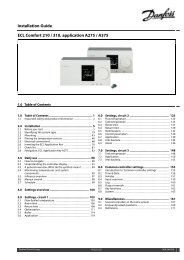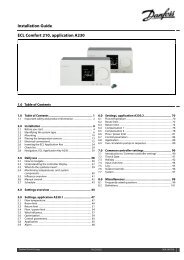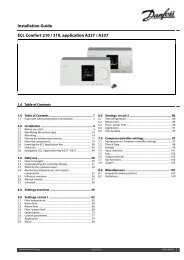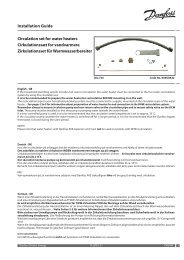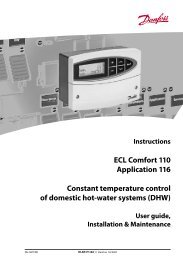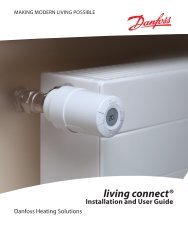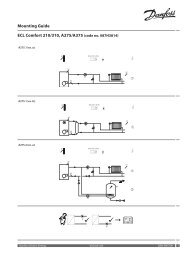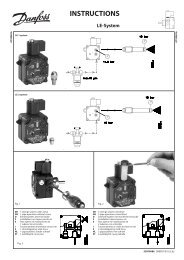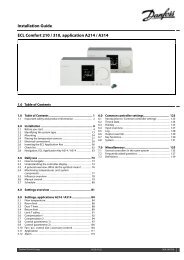ECL Comfort 110 Application 116 Constant temperature control of ...
ECL Comfort 110 Application 116 Constant temperature control of ...
ECL Comfort 110 Application 116 Constant temperature control of ...
Create successful ePaper yourself
Turn your PDF publications into a flip-book with our unique Google optimized e-Paper software.
Checklist, electrical connections<br />
Is the <strong>ECL</strong> <strong>Comfort</strong> <strong>control</strong>ler ready for use?<br />
<br />
Make sure that the correct power supply is connected to terminals 21 (Live)<br />
and 20 (Neutral).<br />
Check that the required <strong>control</strong>led units (actuator, pump etc.) are connected<br />
to the correct terminals.<br />
Check that all sensors are connected to the correct terminals.<br />
Switch on the power.<br />
Choose manual operation as <strong>control</strong>ler mode.<br />
Check that valves open and close, and that required <strong>control</strong>led units (pump<br />
etc.) start and stop when operated manually.<br />
Check that the <strong>temperature</strong>s shown in the display match the actual sensors.<br />
32 VI.KT.F1.02 © Danfoss 05/2007 DH-SMT/DK<br />
Frequently asked questions<br />
The time shown in the display is one hour <strong>of</strong>f?<br />
See the daylight saving time changeover in line 7198.<br />
The time shown in the display is not correct?<br />
The internal clock may have been reset, if there has been a power break for more than 36<br />
hours. Set time and date. See line 1000.<br />
What does the symbol mean?<br />
The flow <strong>temperature</strong> is under influence <strong>of</strong> room <strong>temperature</strong> limitation, return<br />
<strong>temperature</strong> limitation, boost, ramping, heating cut-out, DHW priority etc.<br />
The DHW <strong>temperature</strong> is too high during setback periods?<br />
Make sure that the min. flow <strong>temperature</strong> limitation is not too high. See line 2177.<br />
The <strong>temperature</strong> is unstable?<br />
• Check that the flow <strong>temperature</strong> sensor is correctly connected and in the right place.<br />
• If the <strong>control</strong>ler has a room <strong>temperature</strong> signal (line 3000), check that the Gain is not<br />
too high.<br />
• Adjust the <strong>control</strong> parameters (line 6000).<br />
The <strong>control</strong>ler does not operate and the <strong>control</strong> valve is closed?<br />
• Check that the flow <strong>temperature</strong> sensor is measuring the correct value, see ‘Daily use’.<br />
• Check the influence from other measured <strong>temperature</strong>s ( ).<br />
How to restore the factory settings?<br />
See line 7600.<br />
What does P and PI <strong>control</strong> mean?<br />
P <strong>control</strong>: Proportional <strong>control</strong>.<br />
By using a P <strong>control</strong>, the <strong>control</strong>ler will change the flow <strong>temperature</strong> proportional to the<br />
difference between a desired and an actual <strong>temperature</strong>, e.g. a room <strong>temperature</strong>.<br />
A P <strong>control</strong> will always have an <strong>of</strong>fset which not will disappear over time.<br />
PI <strong>control</strong>: Proportional and Integrating <strong>control</strong>.<br />
A PI <strong>control</strong> does the same as a P <strong>control</strong>, but the <strong>of</strong>fset will disappear over time.<br />
A long ‘Intgr. time’ will give a slow but stable <strong>control</strong>, and a short ‘Intgr. time’ will result<br />
in a fast <strong>control</strong> but with a higher risk <strong>of</strong> oscillations.<br />
DH-SMT/DK VI.KT.F1.02 © Danfoss 05/2007 33



